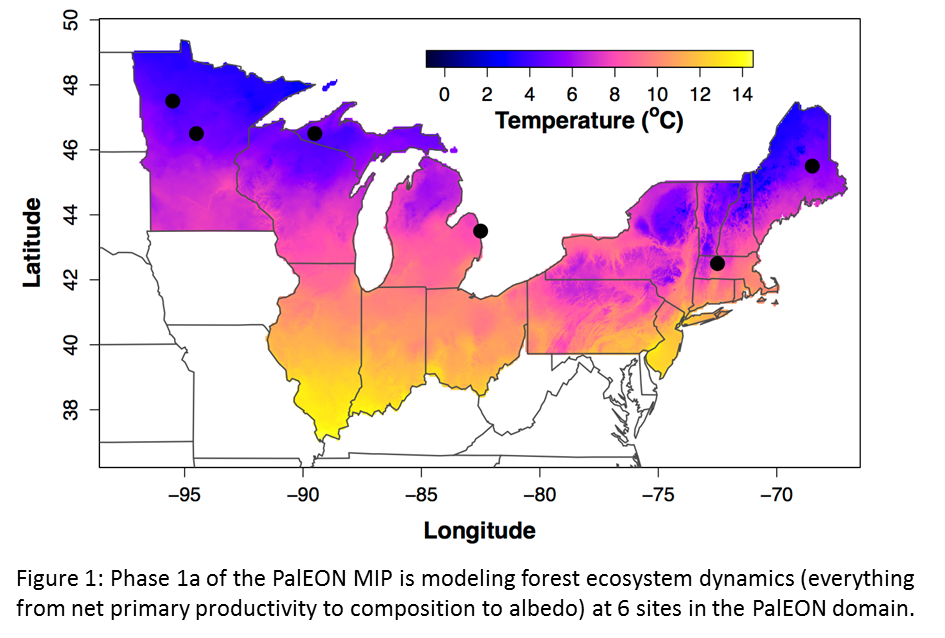
Post by Christine Rollinson, Post-doc at Boston University working with Michael Dietze.
While writing what was intended as a single post about ecological modeling and PalEON, I discovered I had a lot more to say on the topic than I initially thought. In the past year, I have moved from being an ecologist who spends every summer in the field (at a minimum) to one now mired in the world of models and computation. I now see myself as something of a modeling ambassador whose goal it is to demystify the modeling process and increase communication and collaboration between the modeling and field-based ecologists.
This post is the first in a series on the ecological modeling side of PalEON and will focus on describing modeling in general and how it fits into the PalEON goals. Subsequent posts will discuss the modeling process in greater detail and how scientists like myself use these models to answer fundamental ecological questions.
PalEON is collecting and synthesizing data from an incredible array of sources including tree rings, pollen, and historical records. Although we have taken great care to geographically co-locate as much data collection as possible, these data contain information about very different aspects of ecosystems and at very different points in time. How can we combine information on centennial-scale changes in species composition from pollen records with sub-minute carbon fluxes from flux towers? The answer is through models.
Before joining the PalEON modeling team, I, like many other field ecologists, assumed that because terrestrial ecosystem models have been used for a few decades now, the MIP (Model Inter-comparison Project) would merely be a matter of plugging in some meteorology drivers and then analyzing surprises in the output. Oh how wrong I was!
Ecological Modeling 101
Whether we think about it or not, almost all scientists use models in one form or another. The ANOVAs and simple linear regressions we use to statistically analyze our data are models. The terrestrial ecosystem models being used by the PalEON modeling group are essentially dozens, or sometimes hundreds, of these simple models combined. Ecosystem modelers think about these complex models as scaffolds that let us relate physiological mechanisms for change (such as photosynthetic response to temperature) to coarser long-term patterns (such as changes in plant community composition).
As any ecologist will readily tell you, there is a lot about ecosystems that we don’t fully understand yet. There are certain physiological processes such as photosynthesis and respiration that act as building blocks that form the foundation for how terrestrial plant ecosystems function. However, there are still competing methods of characterizing those various building blocks and linking them together. These different representations of how ecosystems function have led to the creation of multiple ecosystem simulation models¹. Rather than limit itself to a single model and theory of how ecosystems function, PalEON is working with an international group of researchers to explore how as many models as possible predict ecosystem change to past environmental variability.
Modeling Past Ecosystem Change
Most of the media attention that discusses ecosystem models focuses on predictions of ecosystem responses to climate change over the next century. However, many of these models were built, parameterized, and tuned to work well for current conditions over a few decades, at most. As scientists, we’ve all been warned about the dangers of extrapolating beyond the range for which we have data (Fig. 2). With PalEON, we are working around this issue by simulating forest responses to past climate change from 850 A.D. through the present. Even though the empirical data for this time period is temporally and spatially sparse, it is better than the literal nothing available for models of the future.
One of the most eye-opening experiences for me has been the discovery that many ecosystem models actually can’t run for hundreds of years at a time. Problems that prevent the models running can range from memory and computation limitations to the simulated thermodynamic physics in the model being impossible. More on the challenges of long-term ecological modeling in the next installment: A day in the life of an ecological modeler. (Spoiler alert: it involves lots of trial-and-error, communication, and XKCD cartoons.)
¹Here I specify simulation model to indicate a class of process-based models that can be given different scenarios (such as climatic conditions) that are used to predict a range of ecosystem states. This contrasts with statistical models that are typically more descriptive in nature and lack explicit representation of processes such as photosynthesis or disturbance.

